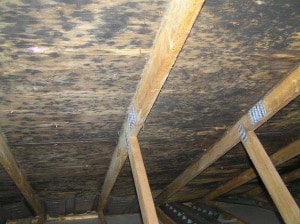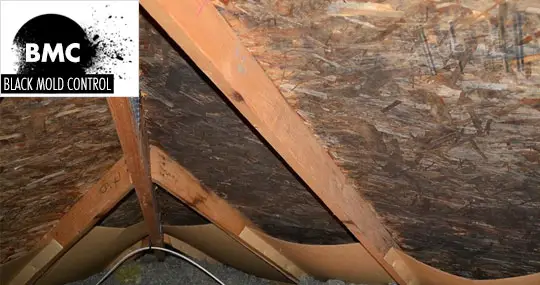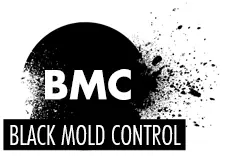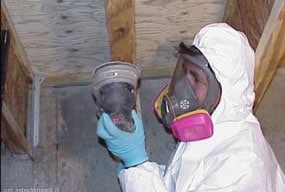Have you found black mold in attic? Don’t wait and hire a professional for remediation! In nature, mold has an important role in breaking down dead organic matter. Mold reproduces through tiny spores that are invisible to the human eye. These spores are floating through the air, and can enter a house through doors, windows, or any other openings.

Usually, the spores have no negative affects when they enter the house. However, if there is a damp or wet spot, the spores can begin to reproduce resulting in mold. Unfortunately, molds can cause health problems when inside a home. Often, molds produce allergens, irritants, and in certain molds even toxic substances known as mycotoxins. For those with asthma, it can trigger severe asthmatic attacks. In addition to the health hazards that mold causes, it can also damage surfaces. Wood, fabric, and leather can be discolored and suffer from long term damage when exposed to mold. It strives anywhere where there is warm, damp air, and as a result, attics are often at risk of hosting mould.
Table of Contents
Different types of mold
Molds come in different sizes, but the health and aesthetic concerns are all the same. They are named according to the colors they grow displaying. They include:
White mold
It thrives in dark and wet areas. Mostly, white fungi is confused for efflorescence because they share the same color. However, white fungi have a musty odor and will develop on wood, concrete, sheet-rock as long as the conditions from growth are met.
Black mold
It grows in moist and warm places. Typically, it appears in black spots cramped in one area and continues to spread if left untreated. Black molds are said to be toxic and causes health hazards.
Green mold
Appears in a green-grayish color that could signal the presence of Penicillium, Cladosporium or Aspergillus. These types of fungi thrive in cool environments such as damp areas found indoors or on rotting food in the refrigerator.
Yellow mold
It is highly toxic and should be eradicated as soon as possible. If it touches the skin, inhaled or consumed, it can cause severe health complications. Yellow fungi is usually found on wood and can cause a great deal of damage if left untreated.
What causes black mold in attic?
Fungi, specifically black mold, is often found in attics for a variety of different reasons. Due to your attic being the closest thing to the roof of your house, any moisture will end up there resulting in black or white mold. However, the cause of a house actually have a black mold problem can be caused by a plethora of different issues.
Poor attic ventilation
Not enough ventilation in the attic is the most common reason for black mold being found in attics in places with cold climates. Additionally, poorly designed attic ventilation can be just as problematic. Some attic ventilation systems are designed so that there is a combination of vents that trap and create pockets of “dead air” that is created from condensation of the decking of the roof in cold temperatures.
Unfortunately, some house designs leave the vents from the dryer, kitchen, bathroom, and other types of exhaust fans in places that cause them to release their discharge into the attic instead of the outside of the house. This can create the perfect setting for black mold.
Condensation by the furnace and water heater
If a furnace and or water heater are set up in a attic with poor ventilation instead of an enclosed area, they can give off enough heat to create condensation in cold temperatures and contribute to mold growth.
Floor insulation
If the floor below the attic is either missing floor insulation, or has a poor moisture barrier installed, heat and moisture from the house and rise into the attic area. This process can lead to the growth of black mildew, especially in cold temperatures.
If the roof is leaking, you’re definitely in trouble. If the roof is leaking, the area of black mold will typically be directly below where the leak is. However, if your attic has poor ventilation, the mold can spread to other areas of the attic.

Is mold in the attic dangerous?
Yes, it could be. Although there are no health problems directly linked to attic mold, it can lead to flares of allergies and asthma. Luckily, attic mold rarely finds its way into the building because of the ‘stack effect.’ This refers to the upward movement of air currents in your house. When warm air rises in your home, it reaches the attic carrying the mold spores. From here, they are eliminated through the venting, which means that they do not get to affect the occupants of the home. Since these movements are not likely to be reversed, most households are safe from attic mold. If the attic mold finds its way into your house, however, it could pose some health risks.


 It’s important to remove mold that you find in your attic. Mold can have harmful health effects for those sensitive to allergens. Thankfully, unless the damage is too great, most furnishings and items can be salvaged. Mold can be removed using simply water and a light detergent, a wet vacuum, a bleach/water solution, or high-efficiency particulate air vacuum. If an item has small crevices or pores, it might be best to throw it away as mold can be extremely hard to remove from those spaces.
It’s important to remove mold that you find in your attic. Mold can have harmful health effects for those sensitive to allergens. Thankfully, unless the damage is too great, most furnishings and items can be salvaged. Mold can be removed using simply water and a light detergent, a wet vacuum, a bleach/water solution, or high-efficiency particulate air vacuum. If an item has small crevices or pores, it might be best to throw it away as mold can be extremely hard to remove from those spaces.